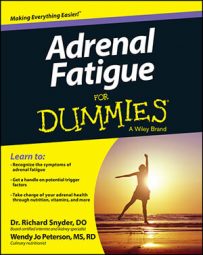People with adrenal fatigue tolerate meditative exercise very well. Meditation-based exercises include yoga and t'ai chi (t'ai chi ch'uan). Yoga is possibly 5,000 years old, and t'ai chi is at least 900 years old. They've lasted because they do people good.
These exercises are relatively slow in pace but can still provide quite a workout. They focus on paced and purposeful movements (if you've ever attended a yoga class or t'ai chi lesson, you know what we're talking about). Here are some of the benefits:
These exercises are energy-promoting, not energy-depleting.
They aren't known to cause drops in blood pressure or changes in pulse rate.
They increase muscle strength and endurance.
They can reduce pain and inflammation.
You should begin with this type of exercise and then slowly incorporating aerobic and/or muscle resistance training. If you have adrenal fatigue, either yoga or t’ai chi should be part of your daily regimen.
Yoga
Yoga is a holistic meditative exercise with roots in India. Like other forms of meditative exercise, it emphasizes concentration and contemplation, deep breathing, and different physical movements. The goal of yoga is not only to treat the physical but also to bring the emotional and spiritual aspects of yourself back into harmony.
If there was ever a “healing practice” better suited for the ongoing treatment of adrenal fatigue, we're not sure what that would be.
Various forms of yoga exist; in the United States, hatha yoga is the best known. You can learn yoga in various ways — by having personalized one-on-one sessions with a yoga instructor (which can be expensive), watching television or instructional yoga videos/DVDs, going to a yoga class, and so on. Advantages of attending a class include:
The connection with others and the instructor in a group setting is a big plus. Exercising alone can be isolating, whereas exercising with others can be a great motivator to keep going.
Although you connect with others, you get a sense of personal space and centering that's very important. The breathing exercises employed at the beginning of most yoga classes are vital in centering yourself and preparing yourself emotionally and physically for the class.
Little or no equipment is needed. In most cases, all you need is to wear fitted pants and tops that aren't restrictive and to get an inexpensive yoga mat. Oh, and you need to bring your whole self to the class as well.
Yoga can be learned, but figuring it out takes time. You need to be patient. Most yoga centers have beginning classes you attend before going on to the advanced classes. The physical movements associated with yoga become more difficult as you advance through each class, but your ability slowly increases. Give yourself time to start at the beginning and learn (and master) things slowly. There are no shortcuts here.
T'ai chi
T'ai chi (t'ai chi ch'uan) has been practiced in China for centuries. It has a lot in common with yoga, with an emphasis on physical movement, proper breathing to find your core center, and balance between the spirit and the body.
Unlike yoga (where you sit or lie down for part of the practice), you usually stand for t'ai chi. T'ai chi consists of defined body movements that are often described as “flowing.” The movements must be learned, but almost anyone can do them, including the elderly and people with some physical limitations. Even a person in a wheelchair can do the arm movements.
T'ai chi can increase your muscle strength and flexibility and can improve your endurance. It can also boost your immune system, so if you have adrenal fatigue and suffer from repeated infections that you never seem to fully recover from, you should strongly consider t'ai chi.
An interesting study reported in the journal Diabetes Care in 2007 examined the effects of t'ai chi on diabetes parameters and immune system health. Diabetes is an example of a chronic illness that causes increased adrenal stress and adrenal fatigue. In this study, a group of 39 people took part in regular t'ai chi sessions over a 12-week period.
At the end of the study, 32 had finished, and the researchers noted the following:
There was a significant decrease in each participant's glycosylated hemoglobin (A1C ) level, which is one way that healthcare practitioners measure diabetes control. Basically, this number measures how controlled your blood glucose levels are over a 3-month period. The lower the levels, the better the control. Diabetes is defined as an A1C value of 6.6 or higher, so most healthcare practitioners aim for a value below that number.
Participants didn't show a significant decrease in random fasting blood glucose levels. This is a good thing because it means that t'ai chi didn't place people at risk of developing hypoglycemia (low blood sugar). Someone with diabetes and/or adrenal fatigue can develop hypoglycemia.
T cell levels increased, indicating an improved immune system. The investigators wanted to assess how the immune system improved by measuring all sorts of T lymphocyte (T cell) functions. T cells are very important in regulating the immune system and fighting off infection. T'ai chi raised the levels of T cells in the body. The better your immune system is functioning, the less stress on the adrenal glands.
Like yoga, you can do t’ai chi at home or in a classroom setting. You should aim to do t'ai chi at least two to three times a week.

